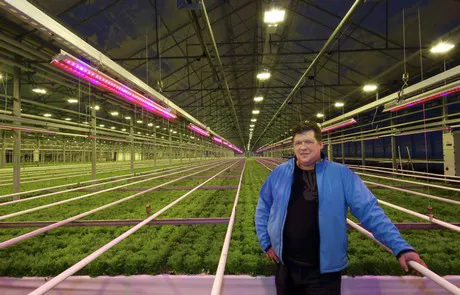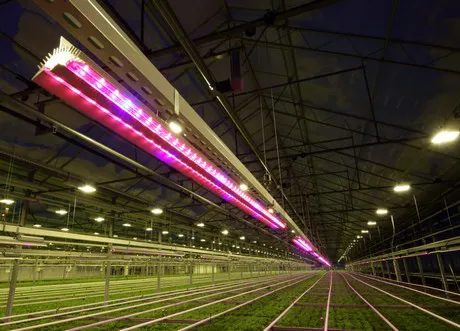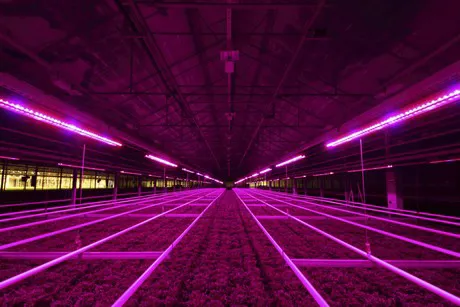First of all, what are the technical details of the installation? What's the height of the luminaries, planting distance. And how many crops are planted per square meter?
Niko Kivioja: The luminaire height is variable, but typically they are kept one meter above the plants. Plant density in the cultivation is 38 pcs per square meter. Electrical power for the LEDs is 30W/sqm. SON-T lighting has been cut down to half of the normal in the hybrid. The purpose of this investment is to gain experience on LED lighted cultivation of Frillice and see could we increase mid winter quality, save energy and gain higher yield. For now the LEDs are only on the last quarter of growing cycle since there the plants grows faster and it also shows the potential of the LEDs in biomass production. Our cultivation method is less applied in peat soil cultivation, but it has proven to be very competitive with state of the art NFT -cultivation methods.

How is the crop doing so far in the first months?
Esa Tamsi: For now we have only harvested the first crops that is grown under the LEDs for one month in normal cultivation process. There hasn't been any problems with technology or cultivation. The Hybrid lighting opens the possibility to adjust the process by using different lighting periods for different technology. By applying the properties of different technologies we are searching good combinations for each natural light conditions and annual seasons. With LEDs we can increase light amount on plant level without increasing heat radiation. On some cases we need the heat radiation as well and then it is good to have SON-T lighting available. This helps us to manage the morphology and quality of the plants.
The quality of the crop seems to be better under the LED's. The morphology is now more compact which makes the plants easier to handle and pack. Compactness also makes high plant densities possible in cultivation. They also have significantly higher dry weight percentage which provides good storage durability, taste and nutritional levels. The quality is actually one of the main aspects why we invested into LED since the wasted crop due to quality issues can be significant during though cultivation times such as mid winter.

Do you have a separate section in the greenhouse to compare results?
Esa Tamsi: We and our cooperative companies have 3,2 hectares of combined lettuce production areas in this same field of which has 500m2 under the hybrid lighting now. So far the yield levels are maintaining similar.
And how about the notable energy reduction so far?
Esa Tamsi: The amount of electricity need is 22% lower in the hybrid system compared to the conventional system. However, since the yield levels are the same, I consider this quite successful already after one month. Still, our goal are to adjust the process now and find out the optimal profitability level of the investment by enhancing quality, yield levels and electricity savings.

Why did you choose Netled?
Esa Tamsi: Netled's grower background gives them a good perspective on aspects affecting on cultivation success. This makes the dialogue with them more cultivation process related rather than technology based. Netled has provided lots of help on LED lighting optimization and they have good collection of research data available to develop the cultivation process with LEDs even after investment.
For more information:
Netled
Niko Kivioja
+358 50 360 8121
solutions@netled.fi
www.netled.fi
